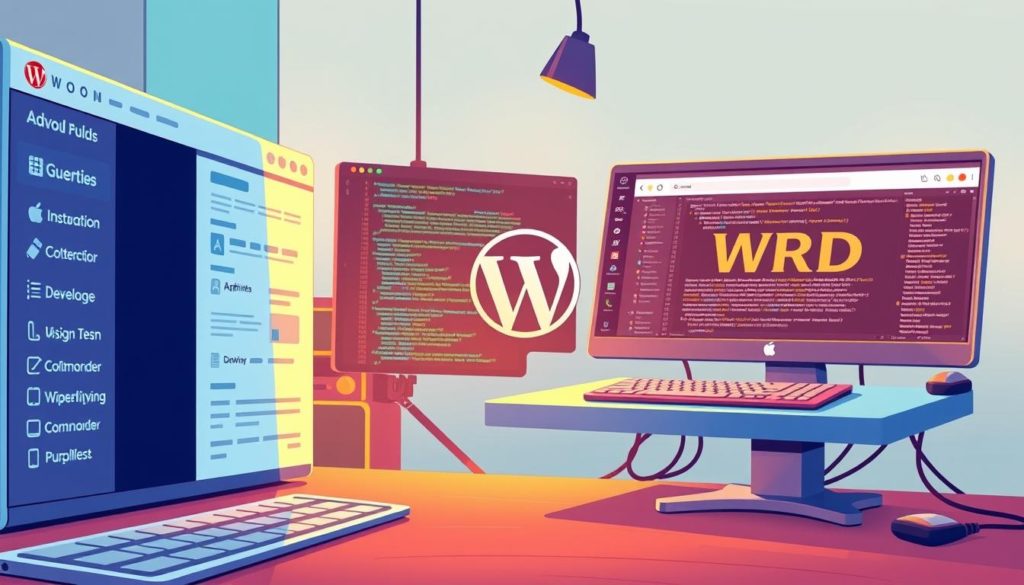
What if the most powerful web development tool isn’t just for bloggers? While many assume content management systems limit technical creativity, over 43% of all websites prove otherwise through highly customized implementations. The secret lies in leveraging open-source flexibility to build solutions ranging from e-commerce platforms to enterprise applications.
This platform’s ecosystem offers more than 60,000 modular extensions and themes, enabling rapid prototyping without sacrificing uniqueness. Developers gain complete control over front-end interfaces and back-end logic, supported by modern features like REST API integrations and headless architecture options.
Demand for specialized technical expertise continues growing, with businesses seeking professionals who can bridge user-friendly interfaces with complex functionality. The community-driven nature of this space ensures constant innovation, making it ideal for those who thrive on solving unique challenges.
Key Takeaways
- Open-source CMS platforms enable limitless customization for projects of all sizes
- Modern development approaches combine traditional methods with API-driven solutions
- 60,000+ plugins and themes accelerate workflow while maintaining creative control
- Technical expertise in this field leads to diverse career opportunities
- Continuous updates and community support ensure long-term skill relevance
Introduction to WordPress Development
Imagine a tool that powers nearly half the internet yet remains accessible to both novices and experts alike. This is the reality of today’s leading content management system, which balances simplicity for content editors with deep technical capabilities for builders. Its ecosystem thrives on collaboration, where even complex projects start with straightforward foundations.
Why WordPress Is a Top CMS
Over 40% of all websites rely on this platform, creating endless opportunities for those who master its framework. The secret lies in its dual nature: a dashboard anyone can navigate paired with tools that support enterprise-level development. Unlike closed systems, its open-source codebase lets teams modify every aspect while maintaining update compatibility.
The Unique Advantages for Developers
Specialized workflows become effortless through modular architecture. Need custom forms or payment gateways? Build them as standalone plugins that integrate seamlessly. The hook system acts like a safety net, allowing modifications without disrupting core files. For modern projects, the REST API transforms the platform into a headless CMS, perfect for apps requiring JavaScript frameworks.
Two distinct paths exist here: optimizing pre-built sites through visual editors or crafting original solutions with code. Both approaches benefit from the same robust system, ensuring your work remains scalable whether you’re adjusting colors or engineering custom post types. This flexibility explains why businesses across industries seek professionals who understand these mechanics.
Understanding WordPress Basics and the Admin Dashboard
Ever wondered how millions manage their online presence efficiently? The answer lies in mastering the central command center where technical control meets practical execution. Accessible through secure login credentials, this interface transforms complex tasks into manageable workflows.

Navigating the Dashboard
Newcomers quickly grasp the layout thanks to clearly labeled sections. Key areas like Posts, Pages, and Appearance streamline content updates and design changes. Developers utilize advanced tools for modifying code structures or adjusting user permissions through granular controls.
The left-hand menu organizes critical functions logically. Media libraries, comment moderation, and plugin directories sit just clicks away. Real-time previews let teams test modifications before pushing them live.
Overview of Themes and Plugins
Visual identity starts with theme selection. Pre-built templates offer instant styling, while custom designs enable unique branding. Over 60,000 plugins extend capabilities without coding – add shopping carts or membership systems through modular installations.
Plugins interact with core systems through specialized hooks. This architecture prevents conflicts during updates. Themes focus on layout and aesthetics, while plugins handle functional expansions. Together, they form the backbone of adaptable digital solutions.
Essential Tools and Resources for WordPress Developers
How do professionals streamline their workflow while maintaining creative freedom? The answer lies in strategic tool selection. Quality resources transform complex tasks into efficient processes, letting developers focus on innovation rather than repetitive chores.
Local Development Environments and Managed Hosting
Local by Flywheel revolutionizes safe testing environments. This free tool creates isolated sandboxes mirroring live servers, enabling risk-free experimentation. Pair it with managed hosting like WP Engine for seamless transitions from local setups to production environments.
These platforms handle technical heavy lifting – automatic backups, security scans, and staging areas. Visual regression testing ensures updates don’t break designs. Developers gain more time for actual coding while infrastructure manages itself.
Code Editors, Task Automation, and Version Control
Visual Studio Code accelerates development speed through intelligent features. Syntax highlighting catches errors instantly, while extensions tailor the environment to WordPress workflows. Combine this with Grunt/Gulp to automate image compression and CSS minification.
Git remains indispensable for tracking changes. Proper branching strategies prevent “code panic” during collaborative projects. As one engineer notes: “Version control isn’t optional – it’s your project’s safety net.”
Smart Plugin Manager exemplifies modern time-saving resources, automating updates while checking for conflicts. These tools collectively reduce debugging hours, letting developers allocate more energy to creative problem-solving.
Learn WordPress as Web Developer
Why do some programmers master this platform faster than others? The answer lies in structured progression. Start with HTML and CSS – they’re the paint and blueprint of every site. JavaScript adds interactivity, while PHP handles server-side logic. Together, these form the foundation for customizing themes and building plugins.

Frontend and backend concepts work hand-in-hand here. You’ll need to visualize user interfaces while managing database interactions. One developer explains: “Understanding template hierarchies prevents endless trial-and-error cycles.” The hook system acts as your control panel, letting you modify functionality without rewriting core code.
Build real projects early. Create a portfolio site, then experiment with child themes. Each challenge teaches more than tutorials alone. Performance optimization and accessibility standards aren’t optional – they’re marks of professional work.
Follow coding guidelines religiously. Clean, secure code integrates smoothly with updates and third-party tools. The ecosystem evolves constantly, so subscribe to core contributor blogs and attend virtual meetups. Balance technical precision with client needs – your solutions must solve problems, not just showcase skills.
WordPress Site Customization vs. Themes and Plugins Development
Balancing visual tweaks with technical wizardry separates casual users from true platform experts. While 78% of projects begin with existing components, strategic modifications determine whether a website stands out or blends in.

Customizing Pre-Made Themes and Using Page Builders
Elementor and Gutenberg revolutionized site building. These tools let teams:
- Drag-and-drop complex layouts
- Adjust color schemes in real-time
- Integrate third-party widgets visually
Child themes protect custom CSS changes during updates. One designer notes: “We deliver client-specific branding in 3 hours using stock themes as foundations.”
| Approach | Required Skills | Best For | Maintenance |
|---|---|---|---|
| Theme Customization | CSS, UI Principles | Quick visual changes | Low effort |
| Plugin Development | PHP, API Integration | Unique features | Ongoing updates |
Building Custom Plugins for Advanced Functionality
When existing tools fall short, custom plugins fill the gap. A recent survey shows 42% of enterprise sites require tailored solutions. Developers use WordPress hooks to:
- Connect CRM systems
- Automate inventory management
- Process encrypted payments
“Custom plugins become competitive advantages when solving niche business problems,”
explains a SaaS platform architect. Properly structured code ensures compatibility with future core updates.
Choosing between customization and development depends on project scope. Time-sensitive sites benefit from page builders, while specialized needs demand original coding. Master both approaches to handle any client request effectively.
Mastering Core Technologies for WordPress
Behind every dynamic website lies a carefully balanced combination of technical foundations. These programming languages and systems work together to create fast, functional experiences. Developers need to know how each piece interacts within the larger framework.
PHP, MySQL, and File Structure Fundamentals
Using PHP remains essential for server-side logic. This scripting language handles user requests, processes forms, and generates HTML for web browsers. Pair it with MySQL to manage databases storing content and settings.
Understanding file organization prevents headaches. Core folders like wp-content and wp-includes follow logical patterns. Proper coding practices here ensure themes and plugins update smoothly.
HTML5, CSS3, and JavaScript: The Building Blocks
HTML CSS partnerships define visual presentation. Semantic tags improve accessibility, while responsive grids adapt layouts. Modern CSS handles animations without slowing page loads.
JavaScript brings interfaces to life. It handles real-time updates and dynamic content loading. Together, these languages create experiences that engage users across devices.
